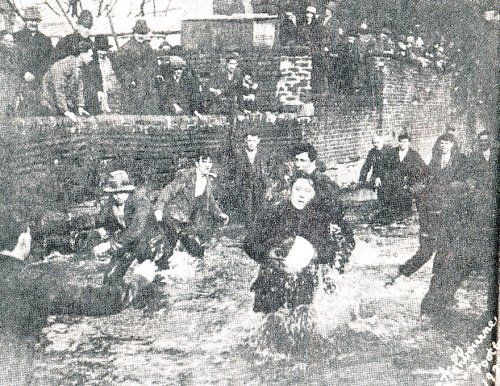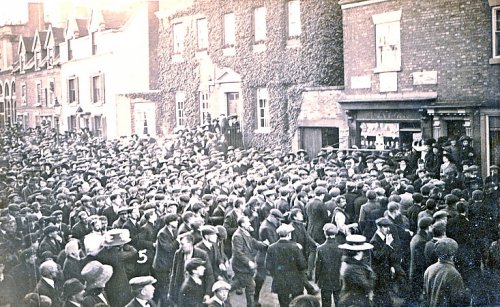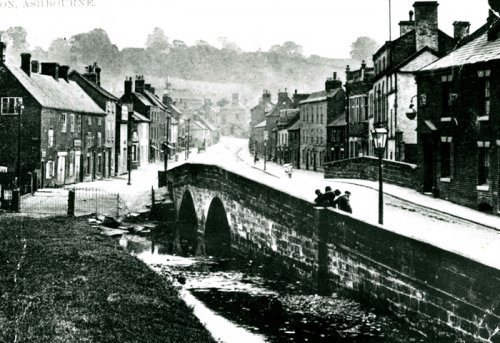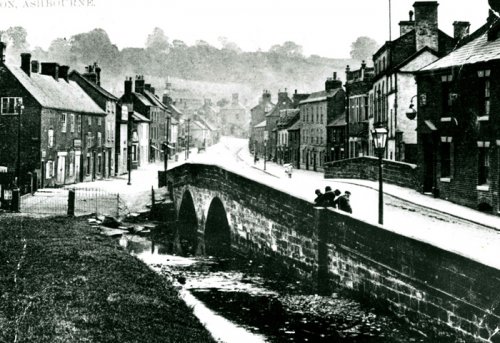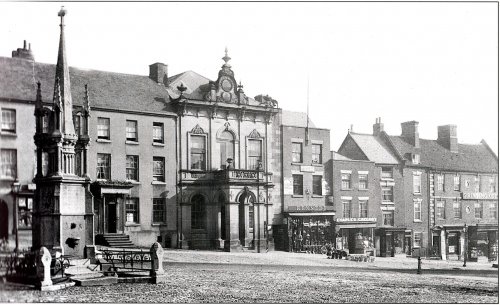One of the earliest rules of Shrovetide Football was - Committing murder or manslaughter is prohibited. One of the latest is - Don't transport the ball in a car.
The Royal Shrovetide Football Match occurs annually on Shrove Tuesday and Ash Wednesday in the town of Ashbourne.
Ashbourne’s Royal Shrovetide Football game is played between the Up’ards, traditionally those from north of the Henmore brook, and the Down’ards, from south of the river. The game starts at the turn-up plinth in the Shaw Croft car park and is played throughout the streets, jitties (alleyways), in the park pond and across fields with 3 miles separating the goals: Sturston Mill for the Up’ards and Clifton Mill for the Down’ards. Traditionally, the goals were scored by entering the wheel house and tapping the ball 3 times against the mill wheel. Since both mills are now demolished, purpose-built stone plinths were erected to represent the mill wheel. The ball is still tapped 3 times but now against the mill stone in the centre of the plinth by a player standing in the river.
Not quite as lawless as its reputation, the game has only a few rules and play is not allowed in gardens, the Churchyard or the Town’s Memorial Gardens, but most of the shops still board up their windows. The game starts at 2pm each day, and re-starts if a goal is scored before 5pm with the game ending at 10pm or at the time of the ball being scored after 5pm. Although mainly a game of “hug”, where the ball is carried around in a large group of players, the ball is quite often in the air where it can be seen by spectators, and there are occasional breakaways. One the most popular origin theories suggests that the game started in Saxon times with the macabre notion that the 'ball' was originally a severed head of a defeated enemy, which was tossed into the waiting crowd, but there is no real evidence supporting this theory.
One of the earliest references for football in the County of Derby comes in a poem from 1683 written after the English Civil War by Charles Cotton cousin to Aston Cockayne, Baronet of Ashbourne (1608-1684). "Burlesque upon the Great Frost. Two towns, that long that war had raged Being at football now engaged For honour, as both sides pretend, Left the brave trial to be ended Till the next thaw for they were frozen On either part at least a dozen, With a good handsome space between 'em Like Rollerich stones, if you've seen 'em And could no more run, kick, or trip ye Than I can quaff off Aganippe." Charles Cotton (1630-1687)[7][8]
In 1797 a pupil of the Grammar School, John Arkwright, wrote home about a game of football at Shrovetide between Grammar School boys and boys of the Town. John Arkwright, aged 12, at QEGS was the son of Richard Arkwright of Arkwright’s Mills at Cromford. Young John’s letter refers to a game against the boys of the Town. He wrote; "Mr. William Walker was so good as to give us a football on Shrove Tuesday and, as we were playing, the town boys came to take it from us: they said they would, only we were too many for them: so we said we would let no more of our boys hinder them from taking it than they had on their side nor no bigger: so we put the football between their feet and no one dare touch it."
Between 1859 and 1891, there were several attempts to ban the game. In 1860, 54 players were summoned to the Magistrates Court; 5 ended up being fined and one of whom – George Brittlebank a local solicitor - having been found guilty represented the other accused. The game originally started in the Market Place by the bull ring in front of the Ex-Servicemens' Club and directly opposite the Town Hall . However, after action by the police at the request of local magistrates, the owner of the Green Man offered Shaw Croft, then a field belonging to the Inn, for the start of the game, and it has started from there ever since. The campaign to stop the game continued until 1891 when 84 players were summoned. However, this had the effect of rallying the whole town behind the game. A concert was held to raise funds for the defence and, at the hearings, the defence solicitor argued that other gatherings which obstructed the highway, such as election hustings or the Meynall Hunt, were not prosecuted. The local council also complained about the expense of bringing in police to take action against the players. Following these arguments, there were no further prosecutions after 1891. In return, the players took on more responsibility by forming a game committee, which continues until this day
The game is started by the “turning up“ of the ball from the plinth in Shaw Croft car park. Up until 1891, the Down’ards “captain” started the game on Shrove Tuesday and the Up’ards on Ash Wednesday. Since 1891, a local dignitary or, occasionally, a celebratory, has been invited to perform the honour and to make a short pre-match speech. Over the years the size of the balls has varied, but the modern one is slightly larger and flatter than a standard football. Each ball consists of one rectangular and two circular panels. The current ball maker is John Harrison. After the ball has been stuffed with cork shavings and sewn, it is given to two local artists who use signwriter’s enamel paint to create a unique design that reflects the career or interests of the invited guest, along with the guest’s name and date.
After the game, the ball is owned by the scorer or, if the ball was not goaled, the guest who threw it up at the start of the game. The “owner” can choose to have the ball repainted back to its original glory. Only one woman has turned up the ball: Mrs Elizabeth Wooley avoided the police intent on preventing the game in 1860 by hiding the ball under her skirt. She threw the ball onto the Market Square from an upstairs window.
The Anthem The song was written for a concert in 1891 which was held in aid of funds to pay fines for playing the game in the street. It is now sung each day at the pre-game luncheon in the Green Man Royal Hotel. Words to the song "There's a town still plays this glorious game Tho' tis but a little spot. And year by year the contest's fought From the field that's called Shaw Croft. Then friend meets friend in friendly strife The leather for to gain, 'And they play the game right manfully, In snow, sunshine or rain. Chorus 'Tis a glorious game, deny it who can That tries the pluck of an Englishman. For loyal the Game shall ever be No matter when or where, And treat that Game as ought but the free, Is more than the boldest dare. Though the up's and down's of its chequered life May the ball still ever roll, Until by fair and gallant strife We've reached the treasur'd goal. Chorus 'Tis a glorious game, deny it who can That tries the pluck of an Englishman."
On 2 occasions, the ball has been turned-up by a Prince of Wales: in 1928 by the later Edward VIII and in 2003 by Prince Charles. However, neither of these is the reason for the game gaining its Royal title. This occurred in 1922 when the people of Ashbourne sent Princess Mary, daughter of George V, a Shrovetide ball on her marriage on Shrove Tuesday to Lord Lascelles. She accepted the ball as a wedding gift and confirmed Royal patronage of the game.
Compton today is just an area of Ashbourne but centuries ago it was an area whose traders were able to undercut the prices of traders in Ashbourne.
This brook is the boundary between Ashbourne and Compton, which was called Scolebrook as early as 1226. From the 1600s onwards it has tended to be called Henmore Brook.
Queen Elizabeth I signed a charter for a Grammar School in 1585. The school opened in 1603 with a central schoolroom on the ground floor, a dormitory above and houses for the headmaster and his assistant either side.
The Green Man was built in the 1750s to service the growing coaching trade in Ashbourne. It had a “drive through” design with a central entrance for coaches and an exit onto neighbouring Dig Street.
On the north side of the Market Place is the Wright Monument. It was “Erected by public subscription to the memory Francis Wright as a record of his valuable services to this town and neighbourhood”
Francis Wright came from a local family and was a successful businessman and entrepreneur. He was a generous benefactor to Ashbourne but opposed Shrovetide Football.



